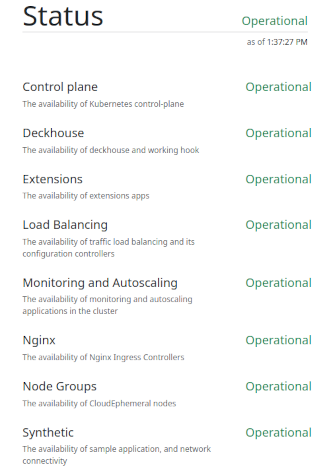DKP can collect statistics about the availability of cluster components and DKP components themselves. This data allows evaluating SLA compliance and provides availability information in the web interface.
Additionally, using the UpmeterRemoteWrite custom resource, you can export availability metrics via the Prometheus Remote Write protocol.
To start collecting availability metrics and activate the interface, enable the upmeter module in the Deckhouse web interface or using the following command:
d8 system module enable upmeter
Module configuration
The upmeter module is configured using the upmeter ModuleConfig:
apiVersion: deckhouse.io/v1alpha1
kind: ModuleConfig
metadata:
name: upmeter
spec:
version: 3
enabled: true
settings:
A complete list of all settings is available in the module documentation.
Interface
DKP provides two web interfaces for availability assessment:
-
Status page.
You can get the page address in the web interface on the main page in the “Tools” section (Status page tile), or by running the command:
d8 k -n d8-upmeter get ing status -o jsonpath='{.spec.rules[*].host}'Example of the status page web interface:

-
Component availability page.
You can get the page address in the web interface on the main page in the “Tools” section (Component availability tile), or by running the command:
d8 k -n d8-upmeter get ing upmeter -o jsonpath='{.spec.rules[*].host}'Example of the component availability page:

Status metrics export
Example of UpmeterRemoteWrite configuration for exporting status metrics via the Prometheus Remote Write protocol:
apiVersion: deckhouse.io/v1
kind: UpmeterRemoteWrite
metadata:
labels:
heritage: upmeter
module: upmeter
name: victoriametrics
spec:
additionalLabels:
cluster: cluster-name
some: fun
config:
url: https://upmeter-victoriametrics.whatever/api/v1/write
basicAuth:
password: "Cdp#Cd.OxfZsx4*89SZ"
username: upmeter
intervalSeconds: 300
Authentication
By default, the user-authn module is used for authentication. You can also configure authentication via externalAuthentication (see below).
If these options are disabled, the module will enable basic authentication with a generated password.
You can view the generated password with the command:
d8 k -n d8-system exec svc/deckhouse-leader -c deckhouse -- deckhouse-controller module values upmeter -o json | jq '.upmeter.internal.auth.webui.password'
To generate a new password, you need to delete the Secret:
d8 k -n d8-upmeter delete secret/basic-auth-webui
You can view the generated password for the status page with the command:
d8 k -n d8-system exec svc/deckhouse-leader -c deckhouse -- deckhouse-controller module values upmeter -o json | jq '.upmeter.internal.auth.status.password'
To generate a new password for the status page, you need to delete the secret:
d8 k -n d8-upmeter delete secret/basic-auth-status
Attention! The
auth.status.passwordandauth.webui.passwordparameters are no longer supported.
FAQ
Why are some upmeter pods periodically deleted or cannot be scheduled?
The module implements availability tests and health checks for various Kubernetes controllers. Tests are performed by creating and deleting temporary pods.
upmeter-probe-scheduler objects are responsible for checking scheduler health. As part of the test, a pod is created and scheduled to a node. Then this pod is deleted.
upmeter-probe-controller-manager objects are responsible for testing kube-controller-manager health.
As part of the test, a StatefulSet is created and it is verified that this object spawned a pod (since actual pod scheduling is not required and is checked in another test, a pod is created that is guaranteed to not be schedulable, i.e., remains in Pending state). Then the StatefulSet is deleted and it is verified that the pod it spawned was also deleted.
smoke-mini objects implement network connectivity testing between nodes.
For testing, five StatefulSets with one replica are deployed. As part of the test, connectivity is checked both between smoke-mini pods and network connectivity with upmeter-agent pods running on master nodes.
Once a minute, one of the smoke-mini pods is moved to another node.